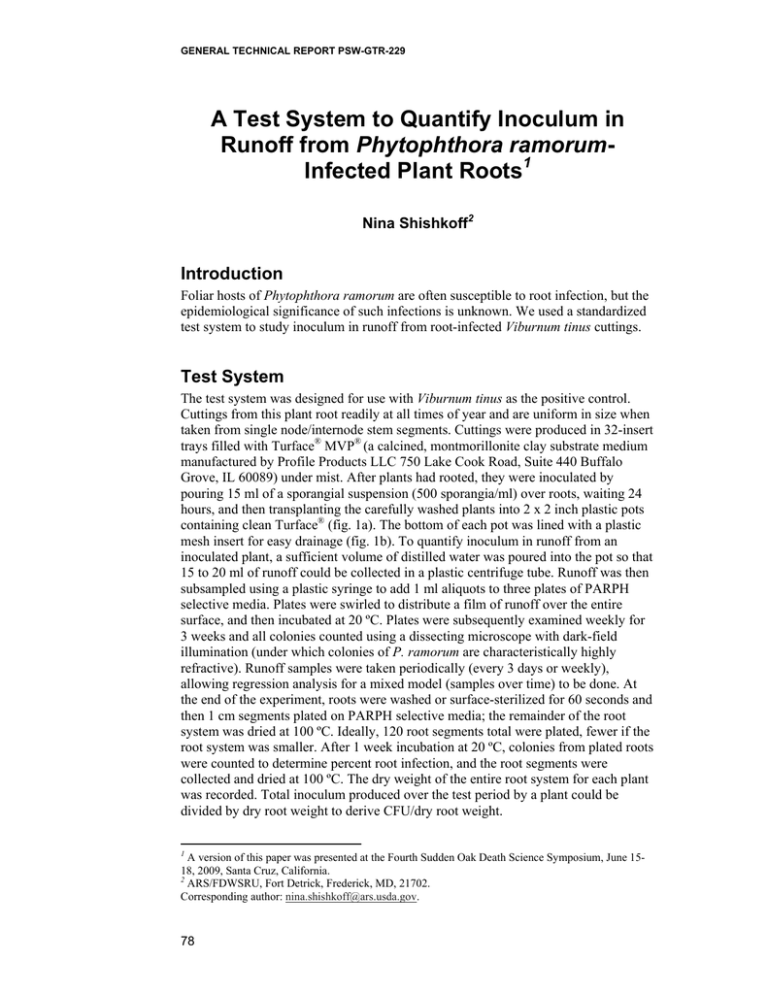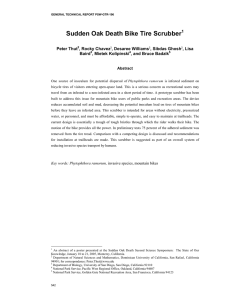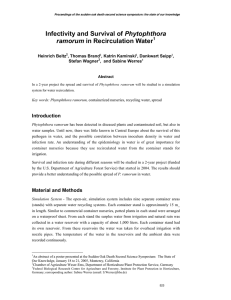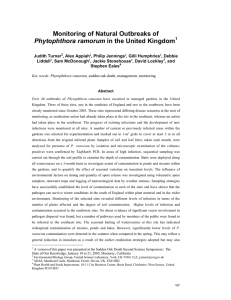A Test System to Quantify Inoculum in Phytophthora Infected Plant Roots
advertisement

GENERAL TECHNICAL REPORT PSW-GTR-229 A Test System to Quantify Inoculum in Runoff from Phytophthora ramorumInfected Plant Roots1 Nina Shishkoff2 Introduction Foliar hosts of Phytophthora ramorum are often susceptible to root infection, but the epidemiological significance of such infections is unknown. We used a standardized test system to study inoculum in runoff from root-infected Viburnum tinus cuttings. Test System The test system was designed for use with Viburnum tinus as the positive control. Cuttings from this plant root readily at all times of year and are uniform in size when taken from single node/internode stem segments. Cuttings were produced in 32-insert trays filled with Turface® MVP® (a calcined, montmorillonite clay substrate medium manufactured by Profile Products LLC 750 Lake Cook Road, Suite 440 Buffalo Grove, IL 60089) under mist. After plants had rooted, they were inoculated by pouring 15 ml of a sporangial suspension (500 sporangia/ml) over roots, waiting 24 hours, and then transplanting the carefully washed plants into 2 x 2 inch plastic pots containing clean Turface® (fig. 1a). The bottom of each pot was lined with a plastic mesh insert for easy drainage (fig. 1b). To quantify inoculum in runoff from an inoculated plant, a sufficient volume of distilled water was poured into the pot so that 15 to 20 ml of runoff could be collected in a plastic centrifuge tube. Runoff was then subsampled using a plastic syringe to add 1 ml aliquots to three plates of PARPH selective media. Plates were swirled to distribute a film of runoff over the entire surface, and then incubated at 20 ºC. Plates were subsequently examined weekly for 3 weeks and all colonies counted using a dissecting microscope with dark-field illumination (under which colonies of P. ramorum are characteristically highly refractive). Runoff samples were taken periodically (every 3 days or weekly), allowing regression analysis for a mixed model (samples over time) to be done. At the end of the experiment, roots were washed or surface-sterilized for 60 seconds and then 1 cm segments plated on PARPH selective media; the remainder of the root system was dried at 100 ºC. Ideally, 120 root segments total were plated, fewer if the root system was smaller. After 1 week incubation at 20 ºC, colonies from plated roots were counted to determine percent root infection, and the root segments were collected and dried at 100 ºC. The dry weight of the entire root system for each plant was recorded. Total inoculum produced over the test period by a plant could be divided by dry root weight to derive CFU/dry root weight. 1 A version of this paper was presented at the Fourth Sudden Oak Death Science Symposium, June 1518, 2009, Santa Cruz, California. 2 ARS/FDWSRU, Fort Detrick, Frederick, MD, 21702. Corresponding author: nina.shishkoff@ars.usda.gov. 78 Proceedings of the Sudden Oak Death Fourth Science Symposium To compare the amount of inoculum produced on plant roots by P. ramorum to that of Phytophthora species specialized as root pathogens, a plant host other than V. tinus was required. Rhododendron is susceptible to a number of Phytophthora root rots; therefore, Rhododendron 'Cunningham's White' was chosen, since it could be easily rooted in Turface and used in such experiments. Experiments To examine the amount of inoculum given off by inoculated roots of V. tinus over 7 weeks, runoff from eight inoculated plants was sampled weekly over 50 days in three trials. Peak inoculum production was observed at 1 to 3 weeks after inoculation. After 50 days, Viburnum roots showed some browning, and percent colonization was 12 to 26 percent. To look at the effect of root age on amount of inoculum in runoff, cuttings were rooted 2 weeks apart and inoculated when the youngest cuttings first produced sufficient adventitious roots. Runoff was collected every 3 days for 16 days. More inoculum was produced on young- (48 to 56 day) and medium-aged (62 to 70 day) cuttings compared to older (79 to 86 day) cuttings in three trials. Percent root colonization did not differ among treatments. When infected cuttings were incubated at different temperatures for 16 days in three trials, both regression analysis and an AOV of total CFU/dry root weight showed that roots incubated at 25 ºC gave off significantly smaller amounts of inoculum. Root colonization was significantly higher on plants at 15 ºC than at 20 or 25 ºC. When four species of Camellia grown from seed were compared to Viburnum cuttings in three trials, root-infected Viburnum tinus gave off significantly greater amounts of inoculum than Camellia species. We also compared the amount of inoculum in runoff from P. ramorum-infected Rhododendron cuttings to that of cuttings infected with P. cactorum and P. citricola, finding little difference in three trials, although percent root infection was significantly lower for P. ramorum than the other two Phytophthora species. . 79 GENERAL TECHNICAL REPORT PSW-GTR-229 Figure 1—A test system to study the production of inoculum by plant roots infected with P. ramorum. Infected plants are transplanted into 2x2 inch plastic pots containing uninfested Turface® potting media and lined at the bottom with a plastic mesh allowing good drainage. a) A pot containing a rooted cutting of Viburnum tinus. b) A pot on its side displaying the mesh insert. Conclusion These results suggest the importance of infected roots in the life cycle of the pathogen, since root infection is difficult to detect, but inoculum in runoff might result in spread of the pathogen 80





